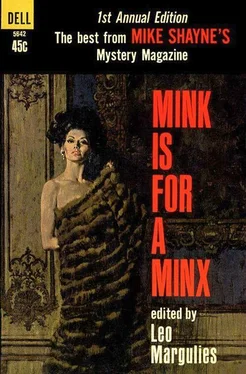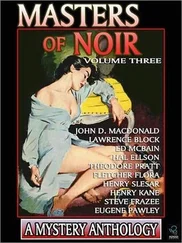The Ford panel truck was driven by Harold J. O’Konski, 31, also out of the army about a year, married, no children. He and his wife ran the Elite Bakery on Harford Road. They lived over the bakery, and O’Konski used the truck to deliver pies, cakes, and other baked goods to restaurants in the northeast Baltimore area. He was laconic, maybe even a bit surly, but he, too, seemed all right.
But a pharmacist and a baker as the brains of a gang that included simple thugs like Byers, Visconti, and Mahaffey? It didn’t add up.
Then, suddenly, everything began to fall into place, as it usually does when the police have done their homework well. A routine check with Identification disclosed that while Heisman was completely clean, O’Konski had been picked up leaving the scene of a crime at a shopping center not far from his bakery and home.
A sporting goods store had been held up about a week before, by four men wearing stocking masks. But O’Konski claimed that he had merely been delivering pies to a restaurant in the shopping center and had tried to speed away when he heard the police sirens, not wanting to get mixed up in anything. They didn’t really have anything on him, and he had been released with a reprimand.
Of course Egan had heard about the hold-up of the sporting goods store, but it was Burglary’s case, not his, and he hadn’t paid too much attention. But with the discovery that O’Konski had been at the scene of the crime, he was all ears. What had been taken from the sporting goods store, he asked Identification.
Five Colt .38 revolvers and about a hundred rounds of ammunition, Identification reported. No money! Only the guns and ammo. The hold-up men had ignored $138.60 in the till.
The M.O. had been the same as in the hold-up of the Texaco station in Towson. The thieves had ignored everything except what they needed for their next job. And, if their previous M.O. meant anything, that next job must be close at hand.
Two days later the complaining Clancy brought in his list of all the locksmiths graduated from trade, YMCA, and night schools during the past ten years. First, Egan had a secretary pick out of it — with the cooperation of Identification — any locksmiths with known criminal records. There were five. One had recently died, two were back in prison, one had spent the last two months in Johns Hopkins Hospital, and one was now a bartender on The Block with an airtight alibi. Nothing there.
Next, he had her pick out all the trained locksmiths who were now engaged in another profession, or were unemployed. There were 247 names on this list.
And, about a third of the way down the list, was paydirt. It read: Heisman, Stuart R. Graduated Ensor Street Commercial and Trade School, June, 1958. U.S. Army, 1958–1961. Present address: 1821 Belair Road. Present occupation: Pharmacist, Belair Drug Store, 1647 Belair Road.
Egan went down the police garage, picked up the black Chevie, and drove out to the Ensor Street Commercial and Trade School. The principal there turned out to be a white-haired old gentleman named Brierly, who had occupied his position for twenty-one years.
“I remember Stuart Heisman very well,” he told Egan. “Quiet, studious boy, with an inventive mind. I remember one thing he put together while he was here. He could have patented it, it was that good.”
“What was that, sir.”
“A key-maker. It was a boxlike thing. It would probe any lock with a very slender gauge and then record the depth of the tumblers, the spring tensions, and all the rest. Then you fed in a piece of metal, turned a dial to the proper setting, and out dropped your new key. I wonder if he ever did anything with it?”
“Well,” said Egan guardedly, “I don’t know, but I think he did.”
Old Mr. Brierly said: “If you could get hold of his friend — they roomed together at the YMCA on Franklin Street while they were in school here — he could tell you more about Heisman. They were inseparable. Went into the army together, as a matter of fact. Oh, what was his name?”
“Was he a locksmith, too?”
“No. He studied welding — acetylene gas welding. Pretty good at it, too.”
“Could it have been O’Konski, sir?”
“That’s it — Harold O’Konski. You know him?”
“A little. Well, thank you, Mr. Brierly. You’ve been very helpful.” Egan rose to go.
The old man said: “I hope Stuart isn’t in any trouble.”
“We don’t know yet. Goodbye, Mr. Brierly.”
At the corner of 33rd Street and York Road there was an all-night diner. The Plymouth parked in front of it and Byers, Mahaffey, and Visconti went in and ordered coffee. Egan parked the Chevie across the street from the diner, and awaited developments. He saw the tan Buick parked about a block back, too far to be identified from the diner.
About five minutes later O’Konski’s Elite Bakery truck appeared, parked behind Byers’ Plymouth, and O’Konski went into the diner. A Chesapeake Telephone Company repair truck passed the diner, turned into a side street, and parked.
Egan breathed a sigh of relief. He picked up the walkie-talkie. “Nice going, phone company. The pigeons are roosting. One more to come. Over and out.”
They didn’t have long to wait. The Mercury appeared, coming slowly up 33rd street, made the York Road turn, and parked. Heisman went into the diner.
It was exactly 4:15 a.m.
Five minutes later Heisman, O’Konski, Byers, Mahaffey, and Visconti emerged from the diner and headed for their respective cars.
Egan grabbed the walkie-talkie. “Same M.O. as before. Take the same car, and for God’s sake don’t lose it!”
The three gang cars all turned into York Road and proceeded slowly south, towards the downtown area, followed at a distance of two blocks by the three police vehicles.
At North Avenue each of the three gang cars suddenly bolted in a different direction. Heisman gunned the Mercury west on North Avenue; O’Konski shot off east towards Harford Road; Byers went straight south on York Road, which at this point became Greenmount Avenue.
Heisman slowed again, then speeded up, turned left on St. Paul Street, and headed downtown. Egan, a block behind, clung to him like a used car dealer to a sweepstakes winner.
The walkie-talkie clicked. Lou Grissom said mournfully: “Sorry, Phil, we lost ours. The Plymouth shook us. It turned east on Biddle Street. A trailer-truck got between us and when we passed it the Plymouth was gone.”
“Never mind,” said Egan. “I think we’re getting close. Come fast and fall in behind me about Monument Street. Over and out.”
At St. Paul and Monument he saw by the rearview mirror that the Buick had come up and was following about two blocks back.
Heisman, apparently satisfied that he was not being followed, turned west off St. Paul Street, crossed Howard in the heart of the downtown shopping and theatrical district, turned into Saratoga, then went left off Saratoga on to Green Street.
He parked two stores down from the Lattman Jewelry Store, a large, flashy emporium that specialized in selling jewelry on time at high interest rates to not too prosperous customers.
The area, although downtown, was a bit seedy. Not far from brightly-lighted Howard Street, it was dark and deserted at 4:45 a.m.
Egan drove slowly past Green Street and saw Heisman parked near the jewelry store. He kept on going and parked on Saratoga, out of sight of Heisman. A chill fall wind keened down the dark, empty street.
The tan Buick passed him, went around the block, and came back up to park on Saratoga, just across Green Street from the Chevie, and also out of Heisman’s sight.
The Elite Bakery truck turned into Green Street off Fayette. O’Konski parked across the street from Heisman and walked over to join the latter in the front seat of the Mercury. Coming into Green off Fayette, he had not seen the Buick and the Chevie parked on opposite corners of Saratoga and Green.
Читать дальше



